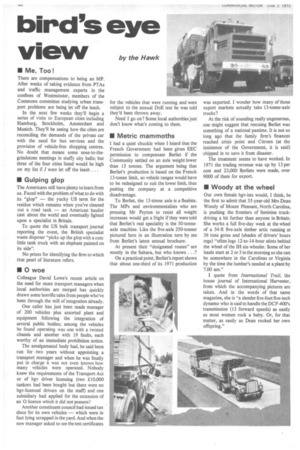bird's eye
Page 46

If you've noticed an error in this article please click here to report it so we can fix it.
view by the Hawk III Me, Too!
There are compensations to being an MP. After weeks of taking evidence from PTAs and traffic management experts in the confines of Westminster, members of the Commons committee studying urban transport problems are being let off the leash.
In the next few weeks they'll begin a series of visits to European cities including Hamburg, Stockholm, Amsterdam and Munich. They'll be seeing how the cities are reconciling the demands of the private car with the need for bus services and the provision of vehicle-free shopping centres. No doubt that means some nose-to-thegrindstone meetings in stuffy city halls; but three of the four cities listed would be high on my list if / were let off the leash .
• Gulping glop
The Americans still have plenty to learn from us. Faced with the problem of what to do with its "glop" — the yucky US term for the residue which remains when you've cleaned out a road tank — an American haulier cast about the world and eventually lighted upon a specialist in Britain.
To quote the US bulk transport journal reporting the event, the British specialist waste disposer "picks up the glop with a cute little tank truck with an elephant painted on its side".
No prizes for identifying the firm to which that pearl of literature refers.
• 0 woe
Colleague David Lowe's recent article on the need for more transport managers when local authorities are merged has quickly drawn some horrific tales from people who've been through. themill of integration already.
One caller has just been made manager of 200 vehicles plus assorted plant and equipment following the integration of several public bodies; among the vehicles he found operating was one with a twisted chassis and another with 19 faults, each worthy of an immediate prohibition notice.
The amalgamated body had, he said been run for two years without appointing a transport manager and when he was finally put in charge it was not even known how many vehicles were operated. Nobody knew the requirements of the Transport Act or of hgv driver licensing (two £10,000 tankers had been bought but there were no hgv-licenced drivers on the staff) and one subsidiary had applied for the extension of an 0 licence which it did not possess!
Another constituent council had issued tax discs for its own vehicles — which were in fact lying scrapped in the yard. And when the new manager asked to see the test certificates for the vehicles that were running and were subject to the annual DoE test he was told they'd been thrown away.
Need I go on? Some local authorities just don't know what's coming to them.
• Metric mammoths
I had a quiet chuckle when I heard that the French Government had been given EEC permission to compensate Berliet if the Community settled on an axle weight lower than 13 tonnes. The argument being that Berliet's production is based on the French 13-tonne limit, so vehicle ranges would have to be redesigned to suit the lower limit, thus putting the company at a competitive disadvantage.
To Berliet, the 13-tOnne axle is a fleabite. The MPs and environmentalists who are pressing Mr Peyton to resist all weight increases would get a fright if they were told that Berliet's real speciality is the 50-tonneaxle machine. Like the five-axle 250-tonner pictured here in an illustration torn by me from Berliet's latest annual brochure.
At present their "designated routes" are mostly in the Sahara, but who knows . ..?
On a practical point, Berliet's report shows that about one-third of its 1971 production was exported. I wonder how many of those export markets actually take 13-tonne-axle trucks?
At the risk of sounding really ungenerous, one might suggest that rescuing Berliet was something of a national pastime. It is not so long ago that the family firm's finances reached crisis point and Citroen (at the insistence of the Government, it is said) chipped in to save it from disaster.
The treatment seems to have worked. In 1971 the trading revenue was up by 13 per cent and 23,000 Berliets were made, over 9000 of them for export.
• Woody at the wheel
Our own female hgv-ists would, I think, be the first to admit that 35-year-old Mrs Dean Woody of Mount Pleasant, North Carolina, is pushing the frontiers of feminine truckdriving a bit further than anyone in Britain. She works a full five-day week at the wheel of a 54-ft five-axle timber artic running at 36 tons gross and (shades of drivers' hours regs) "often logs 12-to-14-hour stints behind the wheel of the IH six-wheeler. Some of her hauls start at 2 or 3 in the morning so she can be somewhere in the Carolinas or Virginia by the time the lumber's needed at a plant by 7.00 am."
I quote from International Trail, the house journal of International Harvester, from which the accompanying pictures are taken. And in the words of that same magazine, she is "a slender five-foot five-inch dynamo who is said to handle the DCF-400's transmission (13 forward speeds) as easily as most women rock a baby. Or, for that matter, as easily as Dean rocked her own offspring."
















































































































































